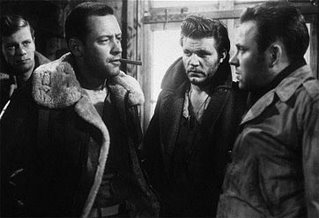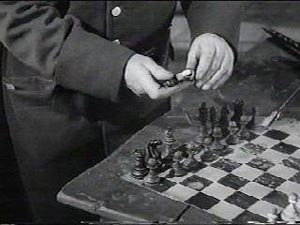Happy Veteran's Day
 Well, sorta. As I'm writing this, it's currently November 12, but I also didn't get a chance to celebrate the boys fighting for our country until 10 PM. I'm just putting my word in for the troops.
Well, sorta. As I'm writing this, it's currently November 12, but I also didn't get a chance to celebrate the boys fighting for our country until 10 PM. I'm just putting my word in for the troops.The blogosphere is abuzz of late. Unfortunately, it's all about the Kazakhs or the Brits, so I thought I'd shine the spotlight back home. And so we have Stalag 17, one of those films that ages like a fine wine. It's not the first, but it strikes me as one of the more even-handed POW films I've seen.
The dynamic of the entire film can be summed up in the credit sequence. We watch a German soldier with a German shepherd walking towards the camera with barbed wire occupying most of the space in the frame. Over this image we hear "When Johnny Comes Marching Home," on the brass while a flute riffs, breaking up the seriousness of this Civil War tune with a bit of lightheartedness. As the soldier comes closer to the camera, he begins to fade, leaving only the barbed wire and a small path.
Similarly, the film alternates between its central plot, that of a rat in the barracks of a POW camp, and the hijinks of a few clowns within that same barracks. The switches can be a bit abrupt, but they never draw you too far out of the movie. Robert Strauss and Harvey Lembeck enliven the parts of Stanislas "Animal" Kasava and Harry Shapiro with a natural chemistry, drawing us into their friendship until we feel we know them as well as they know each other. They serve their purpose well, both enriching our view of Stalag 17 and lessening the overall tension of the film.
Let's get one thing straight before I go any further. This is William Holden's picture from beginning to end. He gives a wonderful performance as J.J. Sefton, and the entire movie rests on his capabilities to show Sefton as a pragmatist first to last while still giving him enough of a heart for the audience to cheer for him. Holden delivers in spades, though he has a slight tendency to overact, especially when with Cookie (Gil Stratton).
The soldiers, whom we as Americans look to be exemplary people, are clearly
 shown as hypocrites, except Sefton. For all the talk about the Geneva Convention and innocent until proven guilty, the men want to hang Sefton for being a rat having seen him get special treatment from the guards and nothing more. They never think of the cigarettes they continually "pay" him as a currency they could use to pay off guards to be more friendly. They see it as unpatriotic to even associate themselves with the Germans, and so they see Sefton as the rat he is not.
shown as hypocrites, except Sefton. For all the talk about the Geneva Convention and innocent until proven guilty, the men want to hang Sefton for being a rat having seen him get special treatment from the guards and nothing more. They never think of the cigarettes they continually "pay" him as a currency they could use to pay off guards to be more friendly. They see it as unpatriotic to even associate themselves with the Germans, and so they see Sefton as the rat he is not.This is not to say that Sefton is any kind of angel. He is probably the worst person in the barracks, enjoying his meals even as he knows others suffer. He cares about no one besides himself, and all of his "patriotic" actions during the film are only to exonerate him from all charges and to escape from the camp. And yet, he's right. He's not a rat, and he never will be a rat.
Herein lies the message of Stalag 17. The blind patriotism shown by most of the men in the barracks is the wrong way to think about our country. It's Sefton's point of view we should adopt, that of the pragmatic skeptic. We cannot always follow the mob, nor should we.
This point of view is expressed in Billy Wilder's direction. Often, Sefton is set apart from the rest of the soldiers. His point of view shots are always of the large mass of people encircling him, looking at him. He's never one of those lookers, even when he has won them over to his side. He doesn't look with the crowd, and so he can see the truth about the rat.
His power, ability and knowledge are summed up in one thing we almost never see Sefton
 without; his cigar. The cigar is, according to basic filmmaking symobolism, the phallus which Sefton possesses to mark him as a strong man. But there is another phallus in Stalag 17, one which belongs to the rat; the chess queen. The rat is able to show his power in public, because it blends in so easily with the rest of the atmosphere. Sefton is the only character we see with a cigar. It is when Sefton reveals the traitor and takes the queen that the rat is powerless. Also, with the phallus revealed for what it is, the traitor is, for the first time, on the receiving end of the gaze Sefton has suffered for the entire film.
without; his cigar. The cigar is, according to basic filmmaking symobolism, the phallus which Sefton possesses to mark him as a strong man. But there is another phallus in Stalag 17, one which belongs to the rat; the chess queen. The rat is able to show his power in public, because it blends in so easily with the rest of the atmosphere. Sefton is the only character we see with a cigar. It is when Sefton reveals the traitor and takes the queen that the rat is powerless. Also, with the phallus revealed for what it is, the traitor is, for the first time, on the receiving end of the gaze Sefton has suffered for the entire film.Besides this symbolism, Wilder's directorial touch is that of a knowing skill. He never shoots to astound us with the image. Stalag 17 was originally a play, and it's appropriate that Wilder, for the most part, shoot it like one. His shots a smooth, fluid, and for the most part, fairly long. However, he never lets the shots go on long enough to distract. The perfect example is the introduction of Sgt. Shulz (Sig Ruman). It's a scene that could easily be done in one shot, and yet Wilder decides to break it into three shots, each giving a further introduction to the characters that dominate that shot. Animal and Shapiro get their own shot, as does Sefton. It's in this knowing break that we get a chance to appreciate how things are structured, not only within the barracks but in the film. Of the three shots, Animal and Shapiro's is the one in the middle. We begin the scene with talk of a traitor, get a dose of comedy, and then return to the serious business. Such is the film.
Stalag 17 remains the classic it is because it combines all the necessary parts to make it great. Its message stands the test of time, as do the direction and acting. And most importantly, it's about the men wearing the uniform, not just the uniform.
****/****


0 Comments:
Post a Comment
Subscribe to Post Comments [Atom]
<< Home